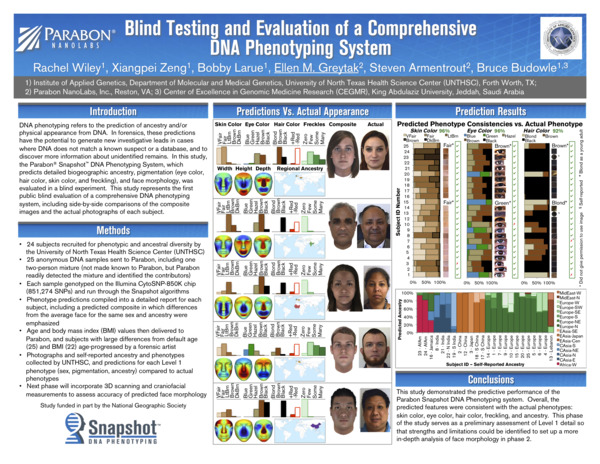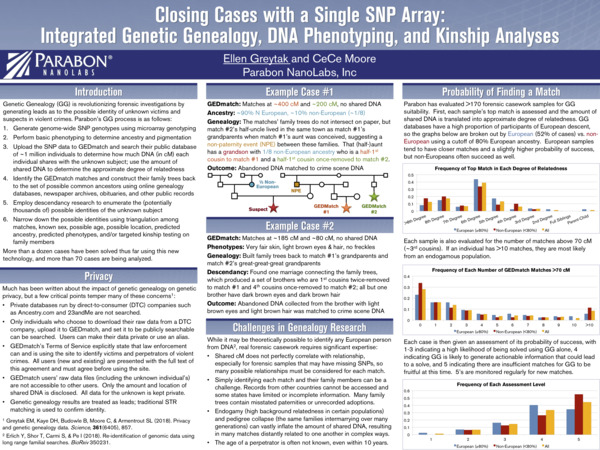Frequently Asked Questions (FAQs) About Snapshot
General
- What is Snapshot?
Snapshot is a forensic analysis service developed by Parabon that can help law enforcement generate new investigative leads, narrow suspect lists, and help solve human remains cases. Using modern SNP technology, Snapshot generates a composite sketch from a DNA sample — a process known as DNA Phenotyping. A Snapshot composite includes sex, ancestry, pigmentation (skin color, hair color, eye color, freckling), and even face morphology. A statistical confidence measure accompanies each phenotype prediction, and phenotype ranges that can be excluded with ≥90% confidence are also reported.
- What type of analysis/reporting does Snapshot provide?
There are two Parabon Snapshot services:
The Parabon Snapshot DNA Phenotyping service reports sex, genetic ancestry — both on a global (e.g., European) and subcontinental (e.g., Scandinavian) scale — eye color, hair color, skin color, freckling, and face morphology. The data is presented in a report with a predicted composite sketch of the individual, along with detailed supporting information that goes into making the composite. A Snapshot sample report can be requested here.
The Parabon Snapshot Kinship service provides probabilistic inferences about the familial relationship between two or more DNA samples, out to six degrees of relatedness (second cousins once removed).
- How does Snapshot work?
Snapshot takes advantage of modern SNP technology. Using bioinformatics pipelines and predictive models developed by Parabon, Snapshot reads genetic content from DNA, which in turn has allowed the creation of datasets that include both genotypic (genetic content) and phenotypic (trait) data for each of thousands of subjects. With the diligent and repeated application of data mining and machine learning processes to such data, Parabon produces statistical models that translate the presence of specific genetic biomarkers into forensically relevant trait predictions.
For more information, please see the following scientific posters we presented at the International Symposium on Human Identification (ISHI):
- What's the difference between STRs and SNPs and why is SNP analysis better?
STR analysis is only useful for matching a sample to a known suspect or a database. The Snapshot technology uses the information about physical appearance encoded in SNPs to generate new leads about unknown suspects.
Ordering
- How does my agency order a Snapshot analysis?
Once we determine what type of sample and laboratory service is required to process your sample, we will send you a customized quote. If you accept that quote and ask us to proceed with the analysis, we will send you and/or your DNA analyst a sample submission form and instructions for where to ship your sample.
- Do I ship the sample directly to you?
No, you will send the extracted DNA to one of our partner labs for genotyping. If you do not have extracted DNA, please ask your crime lab if they will extract DNA from the biological evidence in the case. If they are unable to perform the extraction, we can refer you to a private forensic laboratory that can perform the extraction for your agency on a fee-for-service basis.
For more information, please see our Workflow of a Parabon Snapshot Investigation diagram.
- How much extracted DNA do you need?
Snapshot reports can be reliably produced from as little as 1ng† of DNA; however, if your case has more DNA available, we advise submitting more than 1ng to improve the likelihood of genotyping success. Before accepting a case, we will work directly with your DNA analyst to determine the quantity of DNA that will need to be consumed for a Snapshot analysis. A variety of factors go into this determination including, but not limited to, the total available quantity of extracted DNA, its quality, mixture level, the date and method of extraction, the age of the original biological evidence, and the availability of other biological evidence from which additional DNA might be extracted.
The genotyping assay used for Snapshot analysis calls for nuclear double-stranded DNA (dsDNA) either suspended in elution buffer, distilled water, or submitted as a lyophilized product. Depending on the sample quality, single-stranded DNA (ssDNA) may also be accepted on a case by case basis.
† The genotyping assay required for a Snapshot analysis has produced viable data using 50pg (0.05ng) of extracted DNA, however, at these levels we generally observe lower genotyping call rates, which results in phenotype predictions that have lower-than-normal confidence estimates. In some cases, where almost no information is available about the person of interest, these predictions may still be of value. Please contact us to discuss your case if you have < 1ng of DNA.
- Do you accept cases for which only partial STR profiles are available?
Yes, Parabon can accept cases where the DNA generated a partial STR profile. Partial profiles are typically an indication that there is some sort of impairment to the DNA evidence — e.g., inhibition, mixture, contamination, degradation, etc., and in some of these scenarios Snapshot protocol is nevertheless effective. In addition, partial profiles serve as a warning that we may encounter data loss while genotyping these samples, resulting in lower confidence levels in our final phenotype predictions; the more partial the STR profile (i.e., fewer loci reported) the more risk we associate with the sample. Nevertheless, in some instances, Parabon can accept such cases; customers simply need to understand the risk of possible failure and the trade-off in confidence levels.
- Can mixed DNA samples be used?
Yes, Snapshot can be used to analyze two-person mixtures as long as the unknown person of interest is the major contributor of the mixture. If the minor contributor is >10% contribution, a single-source DNA extract from the minor contributor will need to be provided so that a mixture deconvolution process can be performed. In some instances, Parabon can accept three-person mixture cases, as long as all of the above criteria are met and the third person in the mixture is a trace contributor or ≤10% contribution.
- What is the turnaround time (the time from when the sample is received to when the prediction is returned to the customer)?
The turnaround time for Snapshot analysis is approximately 45 days from the day the genotyping laboratory receives your sample; for Whole Genome Sequencing (WGS), the turnaround time is 8–10 weeks after the sequencing lab begins batch processing.
- Do you accept credit cards?
Yes
Miscellaneous
- We are a genotyping/forensic lab, can we partner with you?
We'd be happy to consider additional partnerships. We are interested in partnering with forensic laboratories that have experience with evidence chain of custody and DNA extraction. We are also interested in partnerships with SNP genotyping laboratories.
- What type of file format do you require from the labs?
We request that labs use Illumina's GenomeStudio software to convert the raw data to Top Allele format, which reports the genotypes as A/C/G/T. We also ask for the results from the sex inference module in GenomeStudio.
- Can I download my raw data?
Raw data is available upon request by the investigator who ordered the analysis. Contact the case manager who has been working with you on your case to make the request. You will be asked to fill out a form acknowledging that you are receiving potentially sensitive genetic information that needs to be kept private, after which the data can be securely transferred.
- I'm unhappy with how law enforcement is handling my case. Can I send you a DNA sample of someone I suspect committed a crime, and have you analyze it?
Currently, we are only providing this service to law enforcement and Federal government agencies. We'd be happy to speak with the detectives handling your case, if they express interest in learning more about the service.
- Who has used the Snapshot DNA Analysis Service so far?
The development of Snapshot was funded by the United States Department of Defense (DOD), specifically the Defense Threat Reduction Agency. As part of the development and validation process, Snapshot has been tested on thousands of out-of-sample genotypes and has been shown to be extremely accurate. In addition to the DOD, Snapshot has been used by more than 100 law enforcement agencies throughout the US, and around the world on hundreds of cases.
Please see our gallery of Published Police Investigations to see some Snapshot posters from cases police have disclosed publicly. Also, please visit the testimonial page on our website to read what our customers are saying about how Snapshot has helped them in their investigations.


